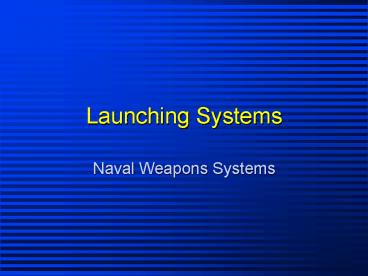Launching Systems - PowerPoint PPT Presentation
1 / 14
Title:
Launching Systems
Description:
Know the basic types of launchers. Comprehend the principles of gravity, impulse and reaction launchers. ... Canister Launchers. Self contained, usually non-reloadable ... – PowerPoint PPT presentation
Number of Views:55
Avg rating:3.0/5.0
Title: Launching Systems
1
Launching Systems
- Naval Weapons Systems
2
Objectives
- Know the general requirements and functions of a
launching system. - Know the basic types of launchers.
- Comprehend the principles of gravity, impulse and
reaction launchers. - Know the different types of impulse launchers.
- Comprehend the principles of gun-type launchers
and recoil systems. - Know the different types of reaction launchers
3
Launching Systems
Purpose To place a weapon into a flight path
as rapidly as the situation
demands.
Requirements
1. Speed Rapid response, quick initial
reaction, high rate of fire. 2. Reliability
Must handle repeat use without failure. 3.
Safety Must be safe for the operators to
use. 4. Compatibility Must be able to operate
in a dynamic environment.
(corrosive forces, vibrations, catapult shots,
etc.)
4
Functions of a Launching System
Storage - Safe and readily accessible until
needed. Transfer - Move from storage to
launcher and back. Loading - Put into
ready to fire position. Control - Direct
and point launcher - Provide Weapons
Orders Launching - Get the weapon away
- Protect ship and people
5
Types of Launchers
- Gravity
- Used with Slow-moving aircraft
- Helicopter launched torp MK-46/50
- Impulse
- The force to separate the weapon from the
launcher is created by the launcher - Reaction
- The force to separate the weapon from the
launcher is created by the weapon
6
Impulse Launching Systems
Two basic types Gun
Ejector
7
- Gun-type Launcher
- Uses gases created by a low explosive
- Internal Stresses
- Recoil/Counter-recoil systems
- Soft recoil systems
Gun launching system produce large stress on the
system
1. Tangential or radial stresses 2. Axial
stresses
8
Recoil Cycles
Battery Position
Battery Position
Time (sec)
Time (sec)
0.0
0.0
0.3
0.2
0.8
2.5
1.4
Soft Recoil
Recoil/Counter-Recoil
9
Muzzle Break
Medium Caliber Howitzer Muzzle Brake
Deflecting Vanes
Projectile
Gases
Functioning of a Muzzle Brake
10
Ejector Type Launching Systems
Ejector -type Launcher Uses gases created by a
high pressure gas system on the launching platform
11
Reaction Launching Systems
Functions
1. The force to separate the weapon from the
launcher is created by the weapon. 2. Provide
the weapon static support prior to launch
and for initial flight orientation. 3. Retrain
weapon until sufficient thrust is
generated. 4. Provide launcher cut-outs to
prevent weapon from hitting own ship.
12
Types of Reaction Launchers
- Rail Launchers
- Rail path needed while weapon accelerates to
achieve stable flight. (Provides initial flight
control, guidance and stability). - Zero Length Launchers
- Weapon usually travels lt8cm before released.
Launcher provides no flight control
13
Types of Reaction Launchers (cont)
- Platform Launchers
- None used by the Navy or USMC (old ICBM trucks)
- Canister Launchers
- Self contained, usually non-reloadable
- VLS, Harpoon Box launcher for Sea Sparrow, ASROC
and Tomahawk.
14
Assignment 13 Homework Chapter 17 2,4, 6, 8,
10, 11 Read Chapter 19 Ballistics and the Fire
Control Control Problem

